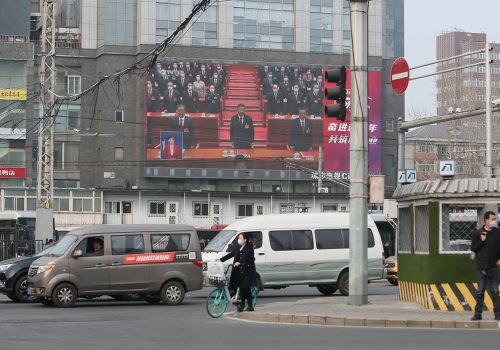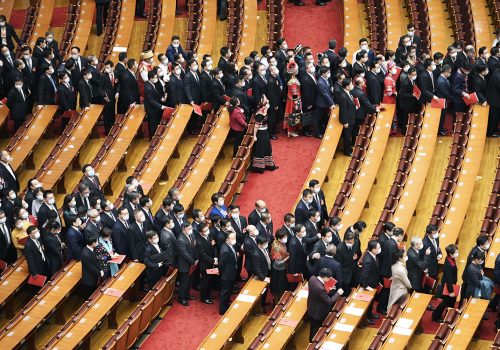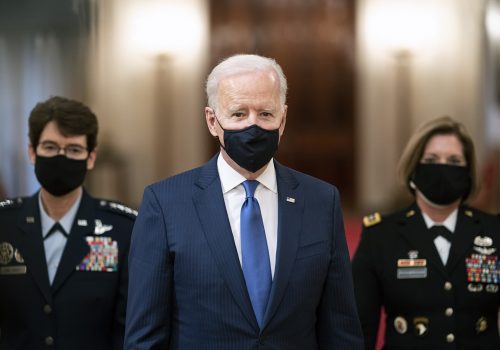Is the US-China strategic competition a cold war?
Ever since the acrimonious meeting between senior US and Chinese officials in Anchorage, Alaska, on March 18, there has been a renewed debate on whether the heightened tension between the two countries should be called a new cold war.
Columbia University professor Thomas Christensen argues in Foreign Affairs that the current US-China strategic competition cannot be labeled a cold war as it lacks three essential and interrelated elements that defined the US-Soviet Union conflict: 1. the United States and China are not engaged in an ideological struggle to win the hearts and minds of third countries; 2. the United States and China are not leading alliances that could foster proxy wars and precipitate nuclear crises; 3. the global economy has become so integrated that it cannot be separated into blocs, and thus a containment strategy will not work. Consequently, writes Christensen, “the voices calling for a cold war containment strategy toward China misunderstand the nature of China’s challenges and therefore prescribe responses that will only weaken the United States.”
However, the question of using or not using the label “cold war” is less important than the reasoning behind the choice. It is critical to strive for a balanced assessment of the rising competition, avoiding both underestimating the challenges posed by China and exaggerating its strengths—as well as those of the West. With a literal comparison of today’s situation with the previous Cold War, one risks underestimating the complexity and seriousness of China’s challenges. Nonetheless, an analysis of Christensen’s three classic Cold War elements can help us better understand the contours of the emerging US-China rivalry.
1. The ideological struggle
While not a struggle between capitalism and communism, the current rivalry over governance models is no less ideological in nature or important to the world. The Biden administration has elevated the concept of rivalry over governance models, which was first formulated by the European Union (EU) to define one component of its relationship with China, as a fundamental difference over core values, from respecting human and democratic rights to abiding by the rules-based international order.
Those basic differences were publicly displayed at the Anchorage meeting. Specifically, the United States criticized China for its actions in Xinjiang, Hong Kong, and Taiwan; aggression in the East and South China seas; and cyberattacks against the United States as well as economic coercion against US allies. Furthermore, the United States made a change in Chinese behavior a precondition to an improvement in the relationship, stressing that these actions are not merely a matter of China’s internal affairs (as Beijing often claims) but rather of grave concern to the international community.
China attacked the United States for interfering in China’s internal affairs, accusing Washington of threatening its security and development interests and not respecting its sovereignty. Furthermore, Chinese diplomats and spokespeople painted the United States as condescending in lecturing other countries on how to behave while not being able to put its own house in order. China emphasized that it will defend its core interests to the utmost.
Besides promoting sovereignty and non-interference in internal affairs as the foundation of international relations—a principle popular among developing countries—China has offered a proven governance and development model: combining political control reinforced by digital authoritarianism with market mechanisms encouraging foreign direct investment and exports. It is, in other words, a model of authoritarian state-led capitalism as opposed to one of open-market democracy. Compared with the largely theoretical promises of communism, China’s real-life achievements with its development model appeal to many developing countries. Meanwhile, democracy and freedom have been on a sustained decline around the world over the past fifteen years. One could say that China has helped make the world safe for autocracies.
Seen in this way, the US-China strategic competition clearly assumes an ideological dimension. As such, it will be difficult to resolve through transactional deals on tariffs or market access, for example. The contention will instead be protracted, with potential for escalation, overshadowing economic competition and possible cooperation in areas of common interest such as climate change.
2. The power of alliances
US President Joe Biden’s approach of dealing with China from a position of strength by building alliances seems to be bearing fruit. Right after the meeting in Anchorage, the United States, the EU, the United Kingdom, and Canada imposed coordinated sanctions on Chinese officials and entities for the treatment of the Uyghur population in Xinjiang. Australia and New Zealand expressed support for the sanctions even though they did not impose any on their own. It is astute of the United States to focus on rallying like-minded countries to hold China accountable for violating international rules and norms, while pledging not to push allies to choose sides.
China has also strengthened its partnerships. Its cooperation with Russia has grown, it has signed a twenty-five year strategic partnership agreement with Iran, and it has built support from a wider range of countries, mainly among participants in its Belt and Road Initiative. In this endeavor, China has not aimed to foster revolution and regime change—as the Soviet Union did—but worked with ruling elites, offering trade and investment opportunities without criticizing them for violations of human rights, corruption, or lack of transparency as the West does. This hands-off approach seems to have worked: Many developing countries came to China’s defense when it was attacked by developed countries for human-rights violations at the United Nations.
The world is gradually coalescing into two broad groupings, espousing different governance values. And while there have been no armed conflicts or proxy wars involving China, hostility in cyberspace has already started—with Russia and China spreading online disinformation to destabilize many Western countries and conducting large-scale hacking operations against Western governments and businesses. Furthermore, US-China tension in the Asia-Pacific has risen significantly, risking escalation to armed conflict through accidents, mistakes, or miscalculations.
3. Economic competition
The global economy has become more integrated, with China’s economy growing strongly—poised to soon take over the United States at market exchange rates and having already done so in terms of purchasing power parity. More importantly, China has become the top trading partner and creditor/investor for many countries. The size and penetration of the Chinese economy have rendered a strategy of containing China impractical and costly to all sides, and makes the US-China contention more protracted and difficult.
The West thus faces a dilemma: Efforts to decouple from China in order to limit its influence would hurt not only China but also Western countries and the global economy more broadly, but striking a trade deal with China to reduce tensions will likely help the Chinese economy perform better, making the strategic competition with Beijing more intractable.
The rivalry has slowly led to a bifurcation of the global economy, most discernible in high-tech areas such as the tension between digital authoritarianism and digital liberalism, artificial intelligence and surveillance technologies, satellite-based navigation for civilian and military uses, and 5G/6G telecommunications.
A balanced assessment
It’s important to remember that China has many weaknesses, including an aging population with a shrunken labor force, a secular decline in labor productivity, high levels of debt, environmental degradation, and social and economic inequalities. It is still an open question whether China can graduate from its old and trusted development model of mobilizing massive investment for exports to one driven by innovation—a model that tends not to thrive under political control.
However, it is equally important not to underestimate the domestic challenges facing the United States and several European countries. Confronted by aging populations and declining productivity, many affluent Western countries have been beset by populist backlashes against economic inequalities and social problems. Especially in the United States, the division has deepened to the extent that there is no shared perception of reality, let alone common ground for debate. This makes it difficult for the United States to build political consensus behind any sustained actions needed to deal with its challenges—even though the country has managed to overcome difficulties in the past and could do so again.
With or without the label “cold war,” the United States and China are locked in a protracted conflict over core national values, including economic and geopolitical interests. The fact that the Chinese economy is stronger than the Soviet Union’s decrepit economy, playing a key role in integrated global supply chains, while many Western countries suffer from internal divisions, makes the strategic competition more challenging for the West than the Cold War of the late twentieth century was. Of particular concern is the fact that the United States has suffered a steep fall in its Freedom House “Freedom in the World” score since 2010, denting much of its soft power. Consequently, the contestants in today’s conflict appear to be more evenly matched, making for a difficult struggle ahead—whatever you want to call it.
Hung Tran is a nonresident senior fellow at the Atlantic Council’s GeoEconomics Center, former executive managing director at the Institute of International Finance, and former deputy director at the International Monetary Fund.
Further reading
Image: US Secretary of State Antony Blinken speaks while facing Yang Jiechi, director of the Central Foreign Affairs Commission Office, and Wang Yi, China's State Councilor and Foreign Minister, at the opening session of US-China talks at the Captain Cook Hotel in Anchorage, Alaska on March 18, 2021. Photo via Frederic J. Brown/Pool and REUTERS.


